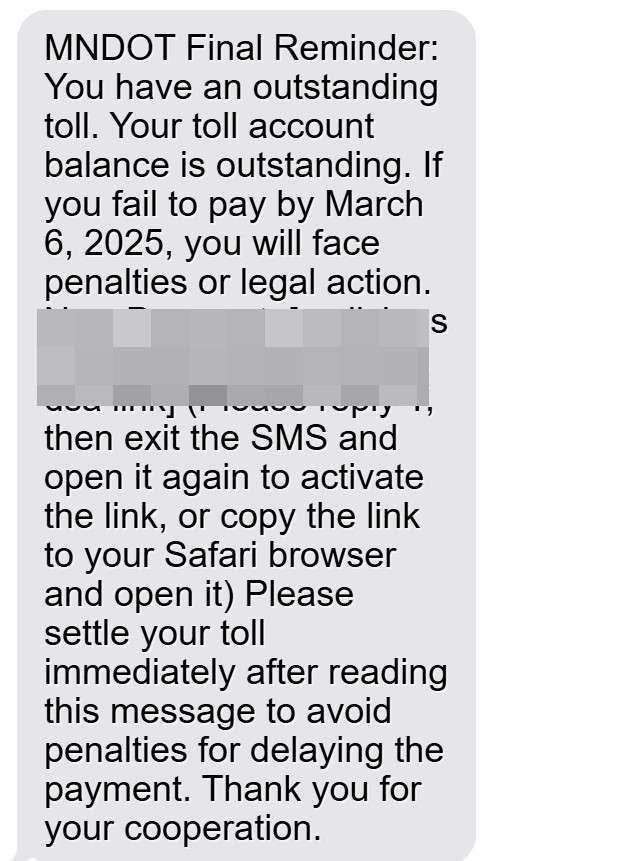Cruising Minnesota’s highways with MNDOT should be smooth riding. But some digital scammers aim to run drivers off the road with a bogus “outstanding toll” text scam.
This trickery starts with a message stating the recipient owes MNDOT toll money. To avoid penalties, it directs them to click a link and pay immediately. However, it’s a sneaky fraud trying to steal personal data and money.
Keep reading and I’ll fully showcase this MNDOT toll scam – how it ensnares innocent Minnesotans and most crucially, how to avoid falling into this trap.

Overview of the MNDOT “Outstanding Toll” Text Scam
This toll payment scam originates with an unsolicited SMS message sent to victims’ mobile phones.
It claims the recipient has unpaid MNDOT toll fees on their account. If not paid promptly by clicking a link, it threatens escalating late fees and penalties.
However, the texts don’t actually come from any official Minnesota toll authority. They are fraudulent messages crafted by scammers to deceive the public and seize personal information and money.
Some key facts about this MNDOT scam:
- Messages spoof real MNDOT numbers but cannot be verified.
- Applies pressure with phony threats of penalties for urgent payment.
- Directs victims to sophisticated fake MNDOT websites controlled by scammers.
- Collects sensitive data and payment info for identity theft and unauthorized charges.
- Results in drained accounts, maxed cards, and extensive identity theft havoc.
This scam started circulating widely across Minnesota in 2022 as more drivers adopted MNDOT. With express lanes crucial to countless commuters and travelers, this fraud jeopardizes many.
But understanding the deceitful tactics is key to avoiding this “outstanding toll” trap, keeping your identity and money secure.
How the MNDOT “Outstanding Toll” Text Scam Operates
Here’s an in-depth look at how the scammers execute this MNDOT toll scam play-by-play:
1. Victims Receive Unsolicited Texts
The scam starts with a text message sent to the victim’s mobile phone, pretending to be from MNDOT billing.
A sample message states:
MNDOT Final Reminder: You have an outstanding toll.Your toll account balance is outstanding. If you fail to pay by March 21, 2025. you will face penalties or legal action. Now Payment:
[malicious link](Please reply Y, then exit the SMS and open it again to activate the link, or copy the link to your Safari browser and open it) Please settle your toll immediately after reading this message to avoid penalties for delaying the payment. Thank you for your cooperation.
The number looks like it could be legitimate. But it’s spoofed and untraceable, not actually tied to any Minnesota toll agency.
2. Threats of Consequences for Non-Payment
The MNDOT texts threaten punishments like fines, registration suspension, or legal action if the fabricated outstanding toll balance isn’t paid immediately.
These intimidation tactics create urgency to click the link and pay without evaluating the validity of the messages. But the threats are completely fictional.
3. Fake MNDOT Links Included
The scam texts conveniently include a link supposedly to pay the invented toll debts.
However, the link leads to sophisticated phishing sites impersonating the real Minnesota Department of Transportation website. The fakes mimic “.com” sites remarkably well to seem authentic.
4. Personal and Payment Information Stolen
On the phony sites, victims are prompted to log into their account to settle the fake toll charges. By doing so, they surrender account usernames, passwords, and payment details the scammers instantly steal.
5. Accounts Looted and Identities Stolen
With the stolen financial information, scammers drain bank accounts, take out cash advances, and run up credit card charges.
Meanwhile, personal data enables them to open fraudulent credit cards and accounts in the victim’s name. Their entire identity is hijacked.
Recovering from the identity theft destruction can take victims years of effort and headaches. But the privacy violation can impact them for life.
What To Do If You Get a MNDOT “Outstanding Toll” Text
If you receive a suspicious text demanding MNDOT toll payment, take these steps:
- Don’t click on any links in texts – they likely go to convincing fake scam sites.
- Don’t call any phone numbers in texts – they cannot be trusted.
- Don’t reply to the text at all. Scammers may verify an active number this way.
- Don’t provide information if you followed a link before realizing the scam.
- Take screenshots of the text message and site as proof of fraud.
- Double check online that the text matches confirmed MNDOT scams.
- Check your account directly through the official Minnesota Department of Transportation website or app.
- Contact MNDOT to report the scam text.
- Monitor statements for any fraudulent charges from scammers.
- Consider blocking the phone number to prevent more scam texts.
How To Avoid Falling Victim to The MNDOT “Outstanding Toll” Text Scam
Here are some tips for Minnesotans to steer clear of fraudulent MNDOT texts demanding payment:
- Remember MNDOT doesn’t text first. Legit notices come by mail before any threats made.
- Watch for bad grammar/spelling. Scam texts often contain errors an official message wouldn’t.
- Verify the phone number. Search online to confirm texts come from MNDOT if unsure.
- Never click text links. Manually type the official Minnesota Department of Transportation URL or use your app.
- Disregard unrealistic threats. No agency imposes instant fees or registration holds over a minor toll debt.
- Don’t “update” account via text. MNDOT won’t request sensitive info over text.
- Setup account alerts. Get notifications from MNDOT for any legitimate toll activity.
- Check statements routinely for any unauthorized charges from scammers.
The Bottom Line – Don’t Get Scammed
This MNDOT “outstanding toll” text scam highlights why Minnesota drivers must stay vigilant against toll tricks. Verify texts claiming you owe tolls directly with MNDOT before trusting links or data requests.
Never let urgency or threats sway you. MNDOT only mails paper invoices for real debts – they won’t text or call out of the blue. Take screenshots of any shady texts and report them immediately.
With prudence, Minnesotans can detect text toll scams, protect identities and money, and continue securely navigating the state’s express lanes with MNDOT. Don’t let scam texts run you off course.
FAQs About the MNDOT “Outstanding Toll” Text Scam
Still have questions about the MNDOT toll scam text? Here are answers to some common questions:
What exactly is the MNDOT text scam?
It’s a scam where scammers send fake texts claiming you owe MNDOT unpaid tolls. The texts threaten penalties to get you to click phishing links and input your personal information.
Who really sends the MNDOT scam texts?
They come from scammers pretending to be MNDOT, not any official Minnesota toll authority. The number is usually spoofed.
What threats do the scam texts make?
They often threaten escalating late fees, registration suspension, collections referral, or legal action if you don’t pay right away. But these are lies intended to trick you.
What’s the purpose of the link in the texts?
The link goes to a fake MNDOT site impersonating the real one. There, scammers try to capture your personal and payment details to steal your identity and money.
What should I do if I get a text about MNDOT tolls owed?
Don’t click any links, provide info, call back, or reply. Check your account directly through the official MNDOT website or app. Report the scam text.
How can I avoid falling for MNDOT toll scams?
Remember real MNDOT only mails a notice first. Never click links or provide data in texts. Ignore threats demanding immediate payment. Routinely check statements for any fraudulent charges.
Who can I contact to report scam texts impersonating MNDOT?
You can alert MNDOT directly, the Minnesota AG, FTC, and your phone carrier to help warn others and shut down the scams.
Red Flags to Recognize MNDOT Toll Scam Texts
How can you discern real MNDOT messages from scam texts aiming to deceive you? Here are some common red flags:
- Originates from an unknown number, not MNDOT.
- Contains threats of instant fees or registration holds for not paying quickly.
- Pressures urgency to pay by clicking a provided link.
- Has typos, grammatical errors, or repetitive phrasing.
- Requests personal information be entered on a site.
- Link goes to a suspicious domain (like “.xin”), not the official Minnesota Department of Transportation website.










